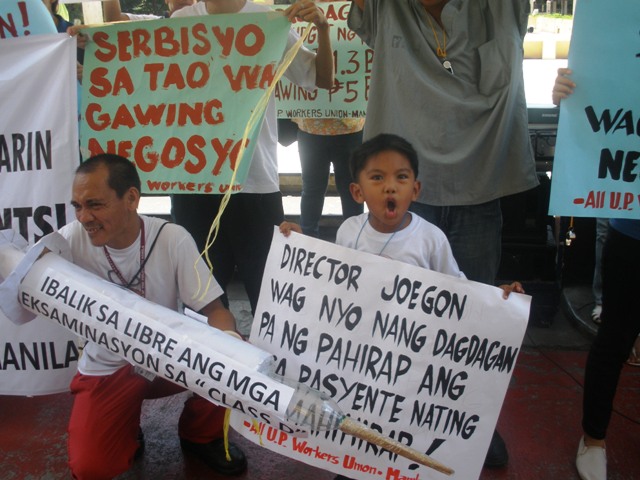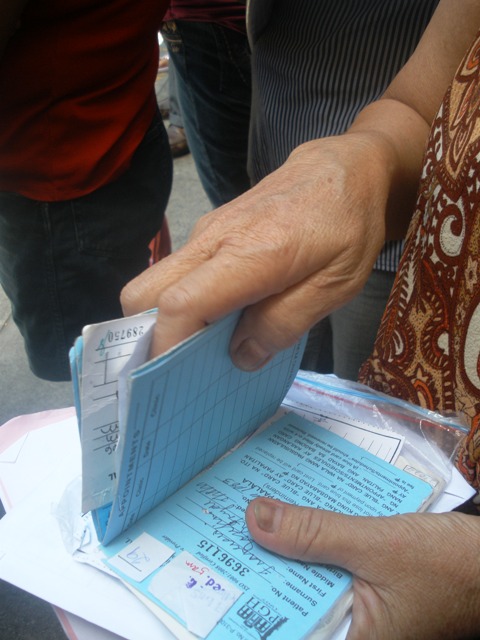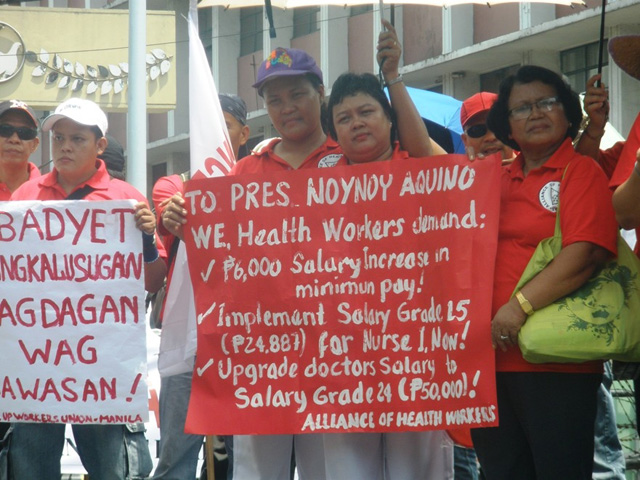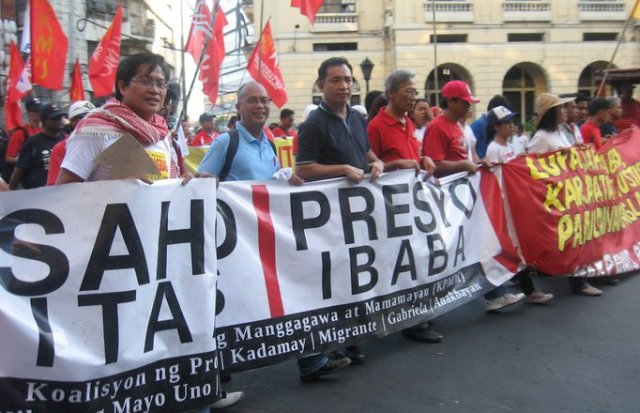Monday, August 22, 2011
Proposed 2012 National Health Budget: A perpetuation of government’s neglect on people’s health and welfare of health workers
August 20, 2011
Reference:
MR. JOSSEL I. EBESATE. RN
National President, Alliance of Health Workers
Mobile Phone: 09189276381
The 2012 proposed budget for health increased by 31.7% from P32.427B in 2011 to P42.693B. However, this deceptive increase is not intended to improve public health services or make public hospitals relevant and accessible to poor patients.
The purported increase goes only on the P12.028B allocation for Philhealth subsidy to the poorest 5.2 million families (20% of the population) and P3B for national government counterpart for PPP projects to be implemented on government hospitals starting next year. Minus the P3.5B allocated for Philhealth subsidy for this year (2011), the health budget actually went down by 5% or P152M.
The Philhealth subsidy for the lowest 20% of the population negates the fact that 80% of our people relied on public health facilities for their health needs. Thus, leaving the next 60% of our people vulnerable to the increased health services that will result in the privatization of health services brought about by the PPP projects in public hospitals. The supposed “zero balance billing” for the 22 most common ailments that will be started this September, covers only the poorest 20% of our people, leaving even those in the formal labor sector (and supposedly covered by Philhealth) to absorb the increased hospitalization cost, in excess of the Philhealth capitation. Furthermore, it is a fact that Philhealth capitation covers only about 30% of the total health care costs.
It also failed to provide additional plantilla positions for public health care facilities in spite of admission from the DOH Secretary himself that public hospitals are understaffed by 300% for nurses alone (1:30 nurse-patient ratio in stead of the ideal 1:10 ratio). The 12,000 nurses for 2012 under the RN HEALS program is only an annual (sic - temporary/contractual) employment opportunity, and a " drop in the bucket" compared to the more than 300,000 unemployed or mis-employed registered nurses. The RN HEALS program is also a form of exploitation of our health professionals, comparable to the "volunteer with fees" in hospitals, because nurses under the said program only received P8,000.00 as monthly renumeration, compared to P17,099.00 starting monthly salary for regular government nurses.
The proposed 2012 national budget further decreased by P3M, the allocation for Magna Carta benefits for public health workers from P714M to P711M; instead of increasing it by P1.5B - to include all public health workers at the DedEd, hospitals under the DOH, and other agencies such as PGH and UP Manila (with P250M shortfall). Ever since the enactment of the law (RA 7305) in 1992, the national government failed to allocate funds for these benefits; thus, hospitals under the DOH have been sourcing their Magna Carta benefits from savings and internally generated funds.
Finally, by centralizing the capital outlay of public hospitals under the DOH (through the Facilities Enhancement Program) (P5.078B) at the DOH Central Office; and all unfilled positions in the government (P23.427B) at the DBM, the Pnoy government only perpetuated the lump-sum appropriations practiced by the previous administration, which have been proven to be the source of large scale corruption.#
Tuesday, July 26, 2011
166 Contractual Workers Summarily Dismissed by DOH Seek “Justice”
Sunday, July 24, 2011
PPPs in health threaten to make health care costlier – health workers - Bulatlat
“You go to a public hospital emergency room to have your wound cleaned, you have to first buy some cotton, wound antiseptic, and dressings, before you can be treated,” said Joel Bitanga, 40, an X-ray technician in San Lazaro Hospital.
By MARYA SALAMAT
Bulatlat.com
Sidebar: Health workers blame Aquino’s PPPs for further crippling the Philippine Orthopedic Center
MANILA – After one year, healthcare in the country has gone from bad to worse — this is the assessment of the Alliance of Health Workers (AHW) on the Aquino government’s impact on health. In a series of protests held by its member unions in different public hospitals in Metro Manila, the group aired the various shocks of Aquino’s touted PPPs (public-private partnerships) on the services of public hospitals and the working condition of health workers and professionals in the country. The group challenged Aquino to stop the privatization “in any form” of public hospitals and to bail out public health by infusing it with a P90-billion ($2.09 billion) budget at least.


UP-PGH health workers urge their hospital management to revert to giving poorest charity patients free treatment. A mother brought out a child patient. (Photos by Marya Salamat / bulatlat.com)
During Aquino’s first year, the country’s main public hospital, the Philippine General Hospital (PGH), for example, has, for the first time in its history, resorted to charging fees even from its lowest ranked charity or indigent patients. In a memo issued last month, the PGH administration reportedly directed its hospital staff to charge the previously free diagnostic and laboratory examinations of “class D” patients. These are the patients who, according to the hospital social workers, belong to the lowest earners or the poorest of the poor among the four groups who qualify for “social service.” Class D used to receive full support (or full charity), while the other classes under social service get discounts, much like the socialized tuition fees being implemented in the University of the Philippines, explained Jossel Ebesate, AHW national president.
In the Philippine Orthopedic Center, fees have been drastically increased early this year, with some increasing more than twice its old amount.
Because of the budget cutbacks implemented by the Aquino administration in the budget for maintenance and other operating expenses of public hospitals, the previous shortages in medicines, supplies and other equipment have become worse, reported the AHW. The exacerbated shortage in turn prompted the administrations of public hospitals to increase fees and to charge fees on previously free items in the hospital menu of services.
“You go to a public hospital emergency room to have your wound cleaned, you have to first buy some cotton, wound antiseptic, and dressings, before you can be treated,” said Joel Bitanga, 40, an X-ray technician in San Lazaro Hospital. He added that if you were brought to their hospital and you can’t breathe, you have to buy the hose and other paraphernalia for your oxygen.


Health workers and a child urge the Aquino government to treat healthcare not as source of profit but as public service.(Photos by Marya Salamat / bulatlat.com)
Picketing in front of San Lazaro Hospital, then at Jose Reyes Memorial Medical Center and in front of the Department of Health, the health workers decried last Monday the increased fees also prevalent in the Philippine Heart Center, the Lung Center of the Philippines, the National Kidney and Transplant Institute (NKTI), the Philippine Children’s Medical Center (PCMC) and the East Avenue Center (EAMC). These are some of the hospitals retained by the national government after it implemented a devolution of health services in 1992.
The practice of charging and increasing fees which the majority of low-income Filipinos are already finding as tough, would likely worsen if the Aquino government pushes through with its planned PPPs targeting even government hospitals, the AHW warned.
Already, the health group noted that some private companies that were able to get concessions in public hospitals have been profiting from this public-private partnership. They cited as example Himex, which provides the radiology “services” of Jose Reyes Memorial Medical Center; the Carte-blance in Lung Center which profits from its dietary services; and Fabricare for Lung Center’s laundry. In PGH, the privately-operated Faculty Medical Arts Building has begun operations this year.
In public hospitals being operated by local government units, a measure of success is the increase in hospital income, which could be
had by adding “private” or “pay wards” and other services that charge fees. The biggest example, for having been the first to be declared as a corporatized hospital is the La Union Medical Center. Provincial hospitals are now trying to follow its example, after its local governments have sent their public hospitals’ directors and staff to “Lakbay Aral” (Study Travel) to learn from “successful” provincial public hospitals.
Up for starting new PPPs soon are the Philippine Orthopedic Center (POC), the San Lazaro Hospital and the Research Institute for Tropical Medicine (RITM). While the moves are seeking to improve and upgrade the said hospitals – something which the health workers’ union said they also wish to happen – they are decrying the fact that these have to be planned under a PPP setup. They urged the government instead to fund the needed development, rather than enter into partnerships with the private sector whose motives for entering health services are mainly for profit.

Health groups blame US imperialist dictates for Aquino’s drive to privatize and commercialize healthcare.(Photo by Marya Salamat / bulatlat.com)
“What will happen to our mentally ill patients? Will they be abandoned on the streets?” asked Arman Palaganas, vice-president of the health workers’ union in National Center for Mental Health. This mental hospital and the Philippine Heart Center are up for bidding in a public auction set to be held under the Aquino administration, the AHW reported.
When all these upcoming PPPs happen, the AHW warned, health care will become even less accessible to ordinary Filipinos.
Killing you softly
Given the frequently slashed budgets, health workers’ wages and benefits have also taken a beating. In fact, the Department of Budget and Management itself has told public hospital administrators and even local government units that benefits being given to health workers are contingent on the hospital’s savings or on the availability of funds. The result, according to AHW, is either lacking or almost nil benefits especially for health workers under the local government units.

A PGH patient’s charity cards and papers attesting to her indigency could mean little now in terms of free or affordable treatment. (Photo by Marya Salamat / bulatlat.com)
For twenty years now, the country’s plantilla position for health workers and professionals have barely increased, despite the continued pressure of population increases. Worse, while the plantilla positions are being controlled, the AHW noted that the ranks of the country’s health workers are under attack and being reduced by bouts of retrenchment or streamlining through transfer, attrition and early retirement.
Instead of replacing the lost regular health workers, AHW noted that the government itself has been increasingly implementing “flexible labor arrangements,” a favorite under profit-oriented corporations. In the health sector, these arrangements range from contractualization, job-order employment (similar to project-based hiring), and the notorious “volunteerism” where the hospitals not only do not pay the health professionals who serve them but even make them pay for the “training” and “experience.”
As if to gag the health workers’ groups who have been criticizing and providing proofs of the government’s abandonment of its responsibility top ensure the people’s health, there are alleged moves from public hospital managements to bust the health workers’ unions, or else “deceive, divide and crush” the progressive unions under the Alliance of Health Workers. The AHW complained that the management of some public hospitals, such as the National Center for Mental Health, Jose Reyes Memorial Medical Center, Philippine Orthopedic Center and Philippine Children’s Medical Center, “do not recognize and even try to coerce the accredited sole bargaining unit.”
As such, judging from the way the government has been treating Filipinos as patients and as health workers, the health group charged that “the people has never been Aquino’s real ‘boss,’ as he had boasted, but the politicians, the local big landlords and the big local and foreign investors.”
The poor cannot survive under the Aquino government’s health agenda of privatization, the Health Alliance for Democracy said in a statement. The poor will get sicker and die sooner if the rate increases continued, said PGH nursing attendant Ellen Jamison in a picket protest in front of the PGH this week.
The health groups encourage health workers and the families of patients in public hospitals to join in protesting privatization and pushing for health as a human right. ![]()
Sunday, May 15, 2011
Aquino’s ‘universal health care’ a sham — health workers
Bulatlat.com
Published on May 12, 201
MANILA— “Other people including graduates of ‘mere four-year-courses’ are earning higher salaries than me,” said a trained surgeon working for years now at a district hospital in a province north of Manila. He said that lack of doctors in their hospital has also forced him to work on “all kinds of cases and not just on an operating table.” Today, he admitted that he is applying for a job abroad. As a surgeon, he thought his career is also in danger here as a new regulation is “being cooked up” by the PRC (Professional Regulations Commission) in Manila requiring people like him to become member of a certain society of surgeons first, before he can renew his license.
Still, this doctor went to Manila and braved the scorching summer heat to join his colleagues from different hospitals and practices in commemorating the National Health Workers’ Day last May 7. The Health Workers’ Day main program peaked at high noon at the Mendiola Bridge.
Almost a year into Aquino’s presidency, health workers complained they “still suffer from low salaries, inadequate benefits and understaffing,” a plight some of them had thought would change under President Benigno “Noynoy” Aquino III. In his election campaign, Aquino was reputedly the only candidate who had promised to take care of public health. But today, a year into his presidency, a bigger allocation of the public purse has been going to militarization and debt servicing rather than public services such as health, said the health workers’ groups.

(Photo by Marya Salamat / bulatlat.com)
An elderly public hospital employee who went on leave to join her fellow health workers in their nationwide protest told Bulatlat.com they had “really believed things would be different with Aquino. But here we are again,” she said, “asking for the same things.”
In commemorating the National Health Workers’ Day last May 7, health workers held a protest caravan from the Lung Center of the Philippines, early morning, stopped for a brief program in front of the University of Sto.Tomas in España, then proceeded by midday to their main program at the Mendiola Bridge near Malacañang. The health workers are demanding a salary increase of P6,000 ($139.75) per month. The Alliance of Health Workers (AHW) said they conducted the Health Workers Day protest also to “continue the fight for jobs, rights and health of the people.”
Tuesday, May 10, 2011
Government employees expose Malacañang’s ‘fake salary hike announcement - Bulatlat
By INA ALLECO R. SILVERIO
Bulatlat.com
Empty lies and pure rhetoric.
According to the Confederation for Unity, Advancement and Recognition of Government Employees (COURAGE) , these are what comprise Malacañang’s post-Labor Day announcement. On May 1, Palace spokespersons said that President Benigno Aquino III has approved a salary adjustment for government workers and that it will be released in June.
Courage president Ferdinand Gaite said the announcement was meant to enhance President Aquino’s image in the eyes of state workers, many of whom have been steadily becoming disillusioned with his administration and its failure to implement significant economic reforms.
According to Gaite, the Aquino administration was trying to fool the public with its announcement.
“Malacañang claimed that administration officials, together with the Department of Budget and Management (DBM) and the president pulled strings just so employee’s demand for a wage hike can be made possible. This is a lie,” he said.
Gaite said that what Malacañang did is to fast-track the implementation of the third tranche of Salary Standardization Law 3 (SSL 3), originally set to be released in July.
 Courage president Ferdinand Gaite joins the Labor Day rally.(Photo by Ina Alleco R. Silverio/ bulatlat.com)
Courage president Ferdinand Gaite joins the Labor Day rally.(Photo by Ina Alleco R. Silverio/ bulatlat.com) “Employees have nothing to look forward to because even before we receive our ‘adjusted’ salaries. The real value of the amount has already been eroded by inflation. Most rank-and-file employees have already committed it to pay their debts,” said Gaite.
The union leader said the second tranche of the SSL 3, the law mandating the staggered pay adjustment scheme passed during the Arroyo Administration, was also released in June last year.
“There’s absolutely nothing for Malacañang to brag about, and even more certain is the fact that government employees have nothing to thank President Aquino for,” he said.
Gaite said that for the country’s rank-and-file government employees who are already struggling to survive amid the rising costs of commodities, the issue is already beyond the SSL 3.He said that only President Aquino and top government officials with enormous pay hikes have benefitted and continue to benefit from the SSL 3.
“As for the rest of us, for the lower-salary grade employees and minimum wage earners subsist on meager wages, the SSL 3 is useless. Even with the full implementation of SSL 3 next year in 2012, the minimum pay will still only amount to P 9, 000 (US$209), way below the government’s estimated average Family Living Wage (FLW) pegged at P29, 640 (US$689.30) per month. We stand by our demand for a P6,000 (US$140) increase to the minimum pay of all government employees.,” Gaite insisted.
Government employees expose Malacañang’s ‘fake salary hike announcement - Bulatlat
Friday, April 29, 2011
Thursday, April 28, 2011
BusinessWorld Online Edition | May Day distress call
No one -- not even employers or the government -- will dispute the sad state of Philippine labor today. The figures do not lie or dissemble. And yet year in and year out, government and employers merely raise their hands and feign helplessness over the situation. They repeat the same old line: wage increases would result in inflation, causing greater woes for workers including the threat of losing their jobs, since higher wages could result in their employers going bankrupt.
Preliminary results of the 2008 Annual Survey of Philippine Business and Industry (ASPBI) of the National Statistics Office (NSO) as cited by IBON Foundation, show that establishments in the country with total employment of 20 and over had combined profits of P895.2 billion and 2.74 million employees.
Even more revealing, the Top 1,000 corporations in the country reaped a cumulative annual net income of P3,788.9 billion over the period 2001-2009.
According to IBON, an across-the-board wage hike of P125 means workers will receive an additional P3,802 per month. Employers will spend an additional P49,427 per employee per year (assuming 13 months of pay). The total cost of the proposed wage hike will only be P135.6 billion which, subtracted from total profits, will still leave establishments with P759.6 billion in profits.
The P125 across-the-board increase called for by the Kilusang Mayo Uno will only cut employers’ profit margins by 15%. Assuming employers will not pass on to consumers any legislated minimum wage increase, there will be no significant inflationary effect. Because their enterprises continue to be profitable, there is no reason for them to close shop.
Consider that the average daily basic pay that wage and salary workers in the country actually received -- as opposed to merely mandated minimum wages that are not necessarily actually paid -- increased from P222 in 2001 to a measly P301 in 2010 (NSO Labor Force Survey, April 2010). The minimum daily wage of P404 in the National Capital Region is not even half of the estimated average family living wage (FLW) of P988 as of March 2011.
A large wage hike will be beneficial not just for workers and their families but also the economy, IBON added. The transfer of money from rich to poor households will increase aggregate demand and stimulate the economy...
BusinessWorld Online Edition |MayDay distress call



